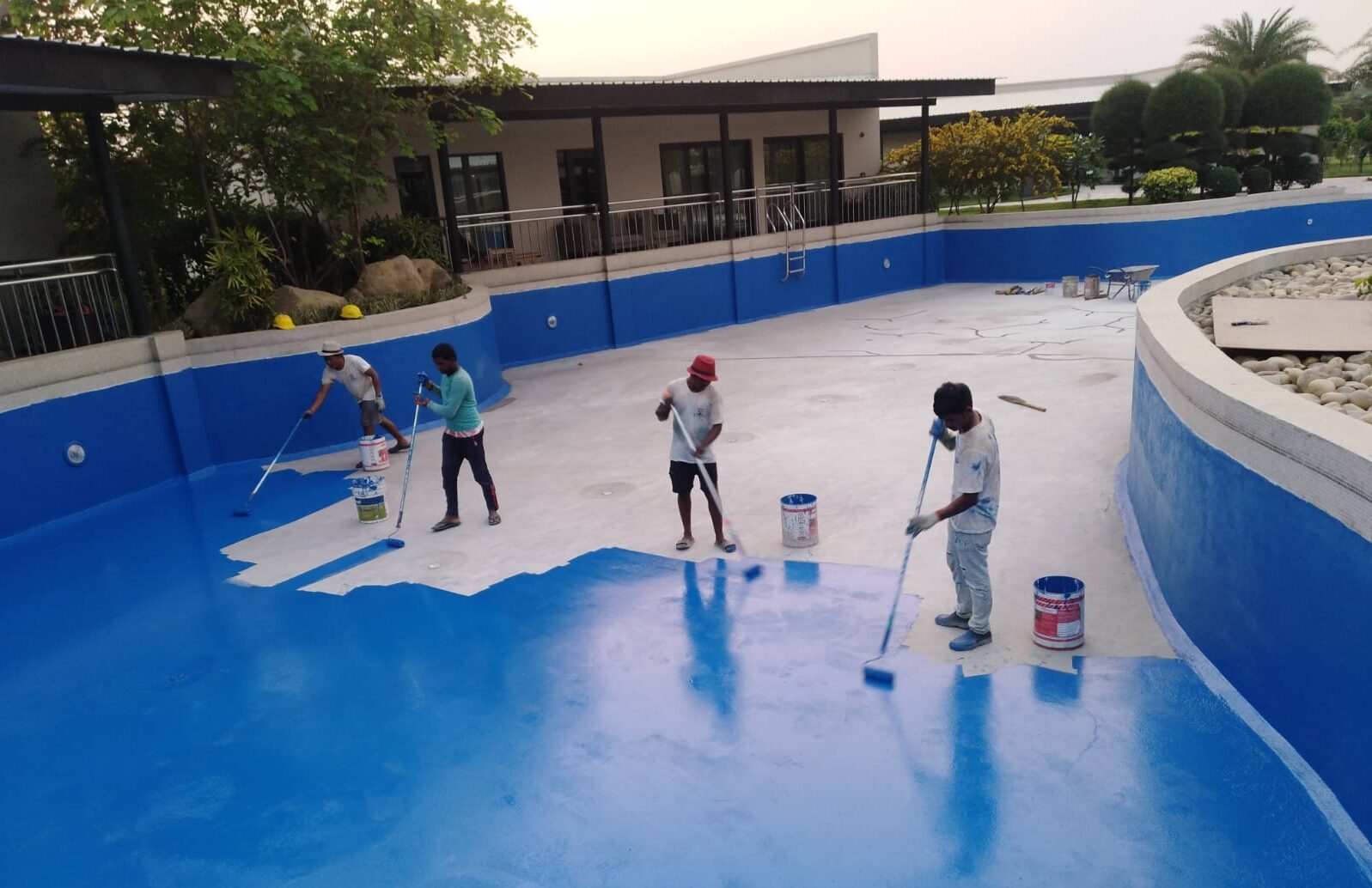
Waterproofing Work in swimming Pool
Swimming pool waterproofing refers to the process of making a pool’s structure impermeable to water, ensuring that it retains water without leaks or seepage. It involves applying materials and techniques that protect the pool’s surface and underlying structure from water damage, prevent leaks, and ensure the longevity of the pool. Waterproofing is critical for maintaining the integrity of the pool, especially since pools are constantly exposed to water, chemicals, and changes in temperature.
Here are the main aspects of swimming pool waterproofing:
1. Types of Pool Surfaces Needing Waterproofing
- Concrete Pools: Concrete is porous and can absorb water, which leads to leaks and potential deterioration over time. Waterproofing protects the concrete structure from water damage and helps prevent algae growth.
- Fiberglass Pools: Fiberglass pools are generally less prone to water penetration, but they may still require a protective coating to maintain their finish and prevent osmosis (the process where water seeps into the fiberglass layers).
- Vinyl Pools: While vinyl liners are waterproof, the underlying structure still requires waterproofing to prevent water leakage or damage to the support structure.
2. Waterproofing Materials and Techniques
There are various materials and techniques used for waterproofing swimming pools:
- Cementitious Waterproofing: A type of waterproof coating that is applied to concrete pools. It’s typically a mixture of cement, sand, and other additives that form a dense, waterproof layer on the pool surface.
- Liquid Membranes: These are flexible coatings applied in liquid form and then cured to form a seamless, waterproof layer. These can be used on concrete, fiberglass, and other types of pools.
- Polyurethane Coatings: These coatings are resistant to water, chemicals, and UV rays. They provide a durable, long-lasting protective barrier for pools.
- Epoxy-Based Coatings: Epoxy coatings are highly resistant to water and chemicals, making them ideal for protecting the structure of the pool and its surface from leaks and degradation.
- Rubberized Waterproofing Membranes: These membranes are applied as sheets or rolls to seal the pool shell. They offer excellent protection from water seepage.
3. Common Causes of Water Leakage
- Cracks in the Pool Shell: Over time, concrete or plaster surfaces can develop cracks that allow water to seep out.
- Faulty Pool Equipment: Leaking pipes, pumps, and filters can also contribute to water loss.
- Damaged Pool Liners: Vinyl liners can get punctured or torn, which may lead to leaks.
- Improper Construction or Design: Poor construction practices can lead to issues like ground movement, resulting in cracks or gaps.
4. Benefits of Pool Waterproofing
- Prevents Water Loss: Proper waterproofing helps prevent water leakage, reducing the need to refill the pool constantly.
- Protects the Pool Structure: It helps protect the pool’s structural integrity by preventing water infiltration that could cause rusting (in steel pools), cracking (in concrete pools), or blistering (in fiberglass pools).
- Reduces Maintenance Costs: A well-waterproofed pool requires less maintenance, as waterproofing helps prevent damage to the pool shell, plumbing, and filtration system.
- Prevents Algae Growth: Waterproofing can prevent moisture from seeping into the pool’s walls, which can reduce algae growth and help maintain water clarity.
- Longer Lifespan: Waterproofing enhances the durability of the pool, reducing the frequency of repairs and extending the pool’s lifespan.
5. Maintenance of Waterproofed Pools
- Regular inspection for cracks or damage to the surface.
- Cleaning and maintaining the pool’s filtration system to prevent leaks from pool plumbing.
- Prompt repairs to any issues found with the waterproofing or the pool’s structural components.
In summary, swimming pool waterproofing is an essential process for protecting the pool from water loss, structural damage, and long-term wear. It ensures the pool remains functional and visually appealing over time, while also saving on repair and water costs.
